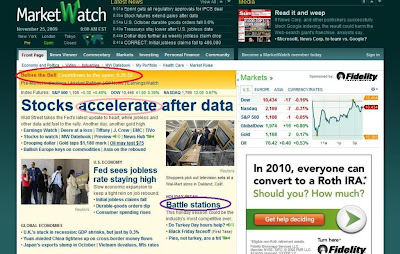Tuesday, December 29, 2009
Investor Sentiment: What Does It All Mean?
Rydex Market Timers: Expecting End Of Year Bounce
Sunday, December 20, 2009
Some Unfinished Business
Saturday, December 19, 2009
Investor Sentiment: On Vacation
Friday, December 18, 2009
What Does That Mean?
Thursday, December 17, 2009
Currency And Country ETF: Japan
Rydex Market Timers: A One Day Event
Wednesday, December 16, 2009
Currency And Country ETF: Australia
Rydex Market Timers: This Is Amazing!
Dollar Index: TheTechnicalTake
Monday, December 14, 2009
Headwinds Abate Slightly
Saturday, December 12, 2009
Investor Sentiment: Stagnation
Friday, December 11, 2009
The Greats Of The Blues: J.B. Lenoir
Thursday, December 10, 2009
ETF's To Buy, Sell, or Hold
Wednesday, December 9, 2009
Developing A Trading Strategy (Part 2)
Tuesday, December 8, 2009
Oil ETF: Oversold
Monday, December 7, 2009
The Technical Take: Dollar Index
Sunday, December 6, 2009
Trends In Gold, 10 Year Treasury Yields, And Crude Oil
Saturday, December 5, 2009
Investor Sentiment: "America Is Back"
You Got To Be Kidding Me
Friday, December 4, 2009
Intra-Day Observations: Anecdotal And Otherwise
Thursday, December 3, 2009
Developing A Trading Strategy (Part 1)
Wednesday, December 2, 2009
Gold v. Currencies v. Gold Sentiment
The Only Chart That Matters
Tuesday, December 1, 2009
Have You Sold Anything Yet?
Advertise On The Technical Take
Thank you for your interest in advertising on The Technical Take. We have approximately 20,0000 unique visitors that view 40,000 pages per month. Engage our valuable demographic of extremely passionate investors through multiple placement options including premium display, buttons and links, email and newsletters, co-registration and lead generation, sponsorships, home page takeovers and other creative advertising solutions.
Available Ad Sizes:
InvestingChannel is one of the fastest growing financial media companies and is our exclusive advertising partner. With InvestingChannel’s seasoned team of professionals, you can optimize your campaigns to maximize return on investment with the highest level of service.
To learn more about advertising on The Technical Take contact InvestingChannel at:
advertiser@investingchannel.com
(p) 646.467.7824
(f) 646.290.8452
www.investingchannel.com
Monday, November 30, 2009
Inflation Pressures Moderating
Saturday, November 28, 2009
Investor Sentiment: Waiting For The "R" Word
Friday, November 27, 2009
Utility ETF Set To Breakout
Wednesday, November 25, 2009
Bond ETF Under Accumulation
Just Catching On
I Am So Breathless






.png)
.png)
















.png)